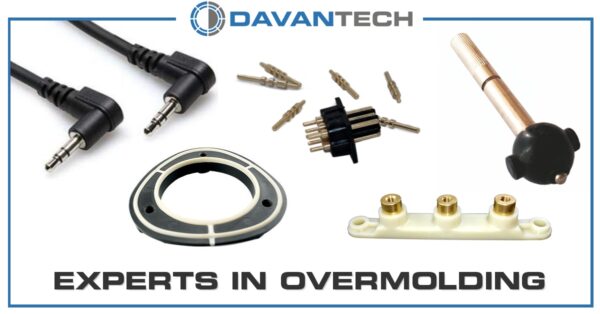We use overmolding in a broad range of products for all kinds of applications. Overmolded parts find their application in electronic devices, electric cables, plastic assemblies, connectors and many more. To understand what the advantages of overmolding are, we first explain the molding process. Overmolding is an injection molding process, where we inject plastic over a primary component. That main component usually is one of the following:
- Another plastic part: to form seals or better grip surfaces
- Electric cables: cable glands and cable splits
- A metal part: metal components and metal connector contact pins
- Or a printed circuit board: Sensor boards and small electronic devices.
One of the main rules in overmolding, is that the melting temperature of the overmolding plastic is lower that the maximum temperature the over-molded substrate can handle. Else, we could damage or destroy the overmolded item. For example, PC can’t be molded to ABS. The reason is that the melting temperature of ABS is lower than for PC. Overmolding often requires precision molds. In addition, the Overmolding usually happens in several steps which makes the investment higher. However, you win back the cost with the advantages obtained by this manufacturing process.
5 advantages of overmolding.
-
Eliminating of fasteners and adhesives.
We mold two or more components together in a single shot or multiple molding shots. We don’t have to use screws, or glue.
-
Reduced assembly cost – reduced part cost.
As mentioned in the remark above, a single operator assembles the product during the molding process. The process is repetitive and as such eliminates mistakes which could happen during manual assembly. In addition, the molding process eliminates manual handling and it reduces the overall unit cost.
-
Improved ergonomics and user experience.
Imagine the rubber grip layers on a handle, a hair dryer or other electric devices. The outer shell of a connector also is overmolded. Two-shot molding and co-injection molding are different manufacturing processes. However, they are following the overmolding principles. And also, this process is the perfect solution for the production of multi colored products and soft grip layers.
-
Flexibility in Design.
Where CNC milling or assembly of different parts with fasteners and glue reduces the flexibility, overmolding gives us the ability to create different, more complex shapes in a single part.
-
Another Advantage of Overmolding: Enhanced Quality and Performance.
It is possible to use an overmolded printed circuit board under water. But also, metal contact pins are isolated from each other in a connector, after overmolding.
